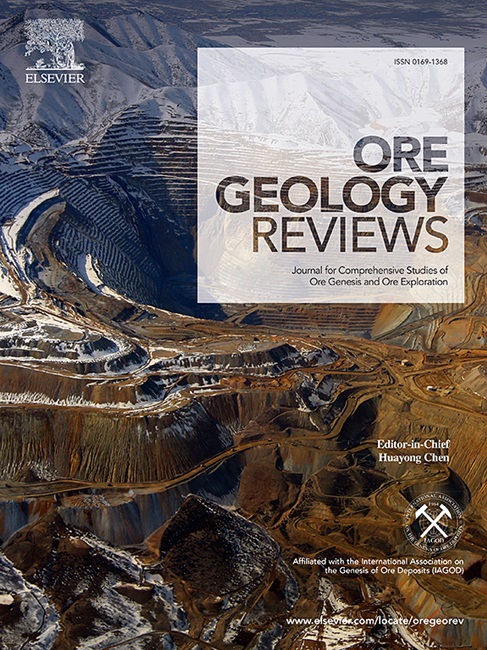利用混合数据和知识驱动方法研究澳大利亚氧化铁铜金潜力及其对IOCG矿物系统形成的影响
IF 3.6
2区 地球科学
Q1 GEOLOGY
引用次数: 0
摘要
氧化铁铜金(IOCG)矿床是全球重要的铜和金来源,也可能包含向低碳经济过渡所需的关键矿物。鉴于其经济和战略重要性,澳大利亚已经采用数据和知识驱动的混合方法对IOCG矿物系统的矿产潜力进行了全国范围的评估。对于该模型,使用Kolmogorov-Smirnov测试对149个可映射标准进行了测试,其中14个标准被确定为与已知的IOCG矿化密切相关,并被保留在模型中。矿产潜力模型成功预测了91.7%的已知IOCG矿床的位置,并在8.3%的区域内找到了产状,将勘探搜索空间缩小了91.7%。根据统计分析,与能源相关的指标是最重要的,其次是成矿梯度、流体路径和构型、金属、流体和配体的来源。新的全国规模模型突出了澳大利亚未开发地区IOCG矿物系统前景提升的几个新领域。根据其地质演化,在Delamerian造山带、Lamboo省和Tanami造山带可能有成矿作用,在西高勒克拉通、Hooper省和Musgrave省可能有成矿作用,在Edmund盆地、Pilbara地区和Yilgarn克拉通不太可能有成矿作用。该研究强调了如何在地质学和统计学的强大框架内评估和利用竞争前的地球科学数据,以产生具有强大预测性能的矿产潜力模型。本文章由计算机程序翻译,如有差异,请以英文原文为准。

Iron oxide copper–gold potential of Australia using a hybrid data- and knowledge-driven approach and its implications for the formation of IOCG mineral systems
Iron oxide copper–gold (IOCG) deposits are a globally significant source of copper and gold, and can also contain critical minerals required for the transition to a low-carbon economy. Given their economic and strategic importance, a national-scale assessment of the mineral potential for IOCG mineral systems in Australia has been undertaken using a hybrid data- and knowledge-driven approach. For the model, 149 mappable criteria were tested using the Kolmogorov-Smirnov test, and 14 criteria were identified to show a strong relationship with known IOCG mineralization and were retained for the model. The mineral potential model successfully predicts the location of 91.7 % of known IOCG deposits and occurrences in 8.3 % of the area, reducing the exploration search space by 91.7 %. Based on the statistical analysis, criteria related to energy sources are the most important, followed by ore depositional gradients, fluid pathways and architecture, and sources of metals, fluids and ligands.
The new national-scale model highlights several new areas of elevated prospectivity for IOCG mineral systems in under-explored regions of Australia. Based on their geological evolution, IOCG mineralization is probable in the Delamerian Orogeny, the Lamboo Province and the Tanami Orogen, possible in the Western Gawler Craton, the Hooper Province and the Musgrave Province, and unlikely in the Edmund Basin, Pilbara region and the Yilgarn Craton. This study highlights how precompetitive geoscience data can be evaluated and utilized within a geologically and statistically robust framework to produce mineral potential models with strong predictive performance.
求助全文
通过发布文献求助,成功后即可免费获取论文全文。
去求助
来源期刊

Ore Geology Reviews
地学-地质学
CiteScore
6.50
自引率
27.30%
发文量
546
审稿时长
22.9 weeks
期刊介绍:
Ore Geology Reviews aims to familiarize all earth scientists with recent advances in a number of interconnected disciplines related to the study of, and search for, ore deposits. The reviews range from brief to longer contributions, but the journal preferentially publishes manuscripts that fill the niche between the commonly shorter journal articles and the comprehensive book coverages, and thus has a special appeal to many authors and readers.
 求助内容:
求助内容: 应助结果提醒方式:
应助结果提醒方式:


